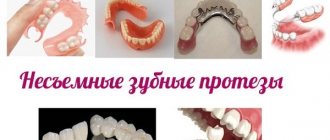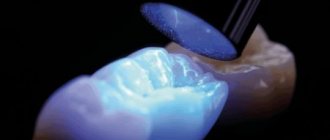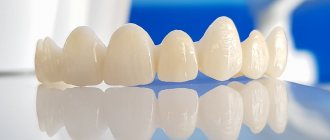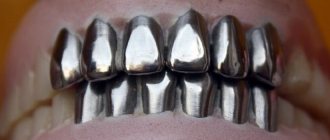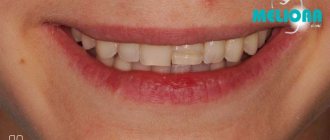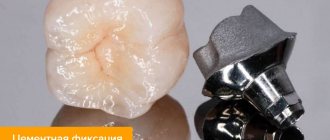- Materials
- Indications
- Contraindications
- Manufacturing and installation
- Advantages and disadvantages
- Care
- Life time
- Alternative Methods
- Advantages of the ROOTT Clinic
- Prices
- Work examples
- Doctors
- Reviews
- When to use:
any group of teeth - Material:
KHS, gold, silver, palladium - Installation time:
2 to 5 days - Features:
minimal tooth grinding, low price, short service life - Service life:
up to 3 years - Anesthesia:
local
Stamped dental crowns are the oldest in the family of single metal dentures. For a long time, stamping was the only method for manufacturing orthopedic systems. Today, such structures can confidently be called a relic of the past. Structurally, they do not differ from similar prostheses; they are made in the form of a steel cap, 0.2-0.3 mm
, which is fixed to the prepared dental unit.
The production of stamped crowns does not require complex technology. Dentures are created manually, from cylindrical metal caps - factory blanks, sleeves. The dental laboratory has steel sockets of different diameters and thicknesses. The technician selects a blank suitable in diameter and begins stamping the crown. Typically, prosthetic structures are gray or golden in color (depending on the material). At the request of the patient, the prosthesis is coated with gold, titanium nitrite, and lined with plastic or ceramic mass for better aesthetics.
Design information - type and features
Stamped crown - what is it? In terms of its purpose, it does not differ from other similar prostheses. This is a cap that covers the tooth from above and restores its apex (i.e., the crown part). The internal parts - the stump and roots - are protected from infection from the oral cavity. The prosthesis restores chewing function and removes “extra” load from neighboring teeth.
Only until 15.01 South Korean implant Osstem - from 18,500 rubles.
Hurry up to sign up for a free consultation and lock in promotional prices.
Call now or request a call
Opening hours: 24 hours a day - seven days a week
The design is made in a simple, one might even say primitive, way - almost the entire production process is done by hand. As a rule, the products are gray or golden in color, less often white, and the thickness ranges from 0.2-0.3 millimeters. What stamped crowns look like is shown in the photo.
Prices
Free online consultation with a dentist
| Service | Price |
| Installation of a metal-ceramic crown (Germany Ivoclar, cobalt-chrome) | from 15,000 rub. |
| Installation of a metal-ceramic crown based on a bio-alloy - gold (Ivoclar Germany + cost of material according to the certificate) | from 25,000 rub. |
Consultation and diagnostics are free!
All prices Promotions
Sign up for a consultation
three ROOTT specialists + diagnostics as a gift
Materials for production
In most situations, stamped crowns are made of metal only. More precisely, from metal alloys of base metals. But noble alloys can also be used here. All materials are intended specifically for dentistry and must meet certain requirements - strength, low susceptibility to corrosion, ease of processing, lack of toxicity, low weight. The following materials (metals and alloys) are used for the manufacture of stamped crowns:
- iron-based alloys (stainless steel, chromium-nickel alloys) marked X18N9: has good ductility, satisfactory corrosion resistance, is inexpensive,
- gold-based alloys (900 or 750 standard): have excellent ductility, do not cause allergic reactions, but are much more expensive than steel,
- alloys based on silver and palladium: almost identical in their characteristics to the previous type, only they have a silver color rather than gold. The price is also considered high.
Advantages and disadvantages
The advantages of these prostheses are quite few. In principle, only two can be distinguished - low cost (if you do not take gold for production) and ease of manufacture. Stamped crowns have many more disadvantages; they look like this:
- low manufacturing precision: therefore, the product does not fit very tightly - a small gap remains between the metal and the gum. Here food remains are retained, plaque and tartar build up - as a result, inflammation or caries begins,
- rapid abrasion, change in shape: opposing teeth (antagonists) can be injured or neighboring ones can be overloaded,
- short service life: the prosthesis quickly loses its fixation due to the destruction of the cement under it,
- low aesthetics: even for lined structures, the color will differ from the general shade of the smile, because plastic is porous - it quickly absorbs dyes and does not bleach well,
- high risk of deformation of the edge of the prosthesis in the area adjacent to the gum or deformation of the apex,
- allergic reactions to base metals are possible: irritation and rashes on the gums occur,
- the gums may acquire a “bluish” tint,
- there is a risk of galvanosis (galvanism): this is the name given to the appearance of an electrical impulse between prostheses made of dissimilar metals (if the patient, for example, already has a crown or bridge made of a different alloy in his mouth)
Dentists against stamped products
Despite the fact that stamped crowns have been used for quite a long time, many modern dentists are against their use due to a large number of shortcomings and imperfections, and prefer more modern types of products.
The result of unsuccessful installation of a stamped product may be the following:
- gradual dissolution of cement due to incomplete adhesion;
- Pieces of food that rot accumulate near the stump;
- caries affects the enamel, and then dentin, sometimes even their complete dissolution;
- The tooth is destroyed and can no longer be restored; it has to be removed.
In addition, the monotonous production of stamped crowns resists the necessary repetition of all the cusps on the tooth surface. A sleeve is taken, which is then shaped by tapping with a special hammer.
Indications for prosthetics
The main indication for installing a stamped crown is severe tooth decay, when it is no longer useful to install a filling or restorative inlay. Additionally, the following indications for prosthetics can be identified:
- frequent occurrence of caries on the causative tooth,
- pathological abrasion of enamel,
- for inclusion in bridges, clasp and acrylic removable dentures,
- abnormal shape of the tooth apex,
- for fixation of maxillofacial and orthodontic appliances,
- for splinting: in case of a jaw fracture or mobility of teeth I-II degrees,
- for prosthetics of primary molars (chewing teeth).
Read on the topic: ceramic inlays - why are they the best replacement for fillings?
Contraindications
Relative
the procedure can be carried out with extreme caution
- Bite defects;
- increased abrasion of the enamel of the antagonist tooth;
- gum pathologies (atrophic, inflammatory);
- pregnancy;
- allergy to anesthetics;
- acute infections;
- mental disorders;
- exacerbation of a chronic disease.
Absolute
the procedure is strictly prohibited
- Severe periodontitis with tooth mobility grade III-IV;
- malignant processes of the oral cavity;
- allergy to prosthesis material;
- decompensated diabetes mellitus.
Preparation and preparation before prosthetics
Before prosthetics, you need to undergo sanitation of the oral cavity - cure dental diseases (caries, gingivitis, etc.). It is imperative to undergo X-ray diagnostics to identify hidden pathologies - for example, cysts under the roots. Then the orthopedic dentist prepares the tooth for a stamped crown - the enamel is ground down by approximately 0.3 mm. This creates the most suitable stump shape for the prosthesis, which will correctly distribute chewing pressure. If necessary, the dental nerve is removed and the root canals are filled. They can also be further strengthened with pins. After this, you can proceed to taking impressions and making a prosthesis.
How structures are made
The technology for making stamped crowns is very simple - it only requires the skills of a dental technician1, consumables, hand tools and 2 dental machines. Let's take a closer look at the laboratory stages of prosthetic manufacturing:
- Stage 1 – taking impressions (in the orthopedist’s office): for this, alginate impression material is used, less often - gypsum,
- Stage 2 – creation of a plaster model (in a dental laboratory): a plaster model is cast based on the impression. It is being finalized - a small depression is formed in the gum area (approximately 0.5 mm). Then hot wax is applied on top to increase the internal diameter of the prosthesis - otherwise there will not be enough space for the cement “glue” when fixed to the support. Afterwards, the plaster “tooth” is cut out from the cast and placed in plaster - the result is a detachable mold with a hole,
- Stage 3 - casting the workpiece : liquid low-melting metal (melting point about 130 degrees Celsius) is poured into the resulting mold - this is how 2 metal tooth models are made,
- Stage 4 – working with a metal sleeve (pre-stamping): 1 metal model of the tooth is taken from the previous stage and its crown part is placed in a metal sleeve (it can be called a “bucket” or “cap”). Next, stretching occurs in the SAMSON apparatus - this is how the standard sleeve takes on a more anatomical shape. After this, the sleeve is fired at a temperature of 1100 degrees and cooled. Then the cap is tapped with a hammer - while the sleeve is compared several times with the 2nd metal tooth (obtained at stage No. 3), because The dental technician needs to recreate the shape very accurately. Next, a metal model of the tooth is melted from the formed sleeve, and the sleeve is fired,
- Stage 5 - second stamping : the sleeve is placed on the second metal tooth and again tapped with a hammer. The workpiece is placed in a device (“press gun”) and compressed under a pressure of 3-5 tons. After this, the workpiece is again tapped with a hammer so that there are no sharp corners, and cut to the level of the gums,
- Stage 6 – finishing (only for single crowns): the workpiece is bleached in an acid solution, ground and polished - since initially it does not look aesthetically pleasing (black, matte). You can also do spraying or cladding. All that remains is to transfer the design to the orthopedic dentist, who will fix the prosthesis to the patient using cement.
If the stamped crown is planned for inclusion in a bridge or removable denture, then after the 5th stage it is transferred to the orthopedist. Next, the doctor fixes the structure to the patient and again takes impressions - this time for the manufacture of an extended prosthesis.
There are also soldered stamped crowns. To make them, the cap sleeve is first cut into 2 or 3 parts, each is modeled by tapping with a hammer, and then all parts are joined into one product by soldering. This method is used when it is not possible to process a solid sleeve on a model.
How long does adaptation take?
How long does it take to get used to stamped crowns? As a rule, adaptation takes very little time - a day or two. It all depends on how well the structure is made and how long the patient walked with a damaged tooth. Since the product follows the anatomical shape, there is no particular discomfort when getting used to it.
Complex on 4 OSSTEM implants with delayed loading - from RUB 170,000.
Complex implantation Osstem (South Korea) with delayed loading after 4-6 months.
Guarantee for the doctor’s work - unlimited Call now or order a call
Opening hours: 24 hours a day - seven days a week
Caring for new teeth
Oral care is also not particularly difficult. As before, you need to take a responsible approach to oral hygiene - brush your teeth morning and evening. Dentists also recommend rinsing your mouth with clean water after every meal. What is best not to do is chew something hard (seeds, candies, nuts) or chewy (taffy, chewing gum), or open lids with your teeth. This can cause the denture to become damaged or fall off the tooth.
It is important to regularly visit your orthopedist for a medical examination so that the doctor can promptly notice the onset of complications - displacement of the prosthesis on the support, exposure or darkening of the gums. It is advisable to go to the dentist 3-4 times a year.
Adequate alternatives to “stamping”
The best alternatives to a stamped crown are modern cast (solid) and milled ones. What is the difference? The differences between stamped and cast are that they have different manufacturing technologies. Cast, as the name suggests, is made by casting. This allows the use of stronger and more durable metal alloys (for example, with cobalt). Cast dentures are precise - they fit better to the support and to the gums, do not wear down over time, and last about 10 years. They can also be coated with a ceramic veneer to enhance aesthetics.
“The doctor dissuaded me from having a stamped crown because it’s a thing of the past. Although it is cheap, it is from the category of “the miser pays twice.” It’s better to immediately make normal metal ceramics, which will last a long time and pay for itself. Somehow I don’t want to go for a new prosthesis every 2-3 years and finish off the tooth with new drillings.”
Ruslan, review from the website stomatology.rf
Another type of dentures is milled. They are modeled in a computer program and manufactured using a computer-controlled milling machine. This ensures the highest precision - the prosthesis fits onto the support without the smallest gaps, which eliminates the risk of microbial penetration. Titanium, aluminum and zirconium dioxides are suitable for milling - the latter are metal-free ceramics and last 15-25 years.
Reviews
Patients at dental clinics do not always experience equal value for money. An example of this is metal structures with spraying. At minimal cost, such products allow you to reliably and efficiently restore the aesthetics and functionality of teeth.
Despite the intensive growth of technological solutions and the use of innovative computer programs in dental practice, the presented devices for dental prosthetics are in leading positions in the list of popular dental prostheses.
A properly selected product can serve its owner for decades, providing maximum comfort.
You can leave your feedback on the advantages and disadvantages of the presented products in the comments below.
If you find an error, please select a piece of text and press Ctrl+Enter.
Tags crowns fixed prosthetics
Did you like the article? stay tuned
Previous article
When is the installation of a plastic bridge justified?
Next article
Aspects of dental implantation in the absence of lower teeth
Cost of dental restoration
Stamped crowns for teeth made of base metal alloys (steel, for example) are relatively inexpensive - about 1500-2000 rubles. If the prosthesis is coated - an acrylic “white” coating will be applied on top, then the price will increase by another 500-1000 rubles. In the case when the prosthesis is made of gold, the price increases significantly, because 1 gram of the noble alloy costs about 5,000 rubles. That is, the cost of such a solution is close to the cost of a solid-cast metal-ceramic crown.
Don't know what type of prosthetics to choose?
We will help in the selection, advise where to read more information and compare types of prosthetics.
Consultation with an orthopedic doctor in Moscow clinics is free! Call now or request a call
Working hours: from 9:00 to 21:00 - seven days a week
Alternative Methods
Ceramic-composite metal-free, lightweight crowns with high light transmittance
Zirconium Durable crowns with high aesthetics, suitable for anterior and posterior teeth
Cast Durable and durable one-piece crowns made of metal alloys with the possibility of veneering
Article Expert
Shirokov Ivan Yurievich Dentist-orthopedist, doctor of the highest category
Work experience: more than 17 years
User Questions
QUESTION Tell me, I have a gray crown on a molar that seems to be stamped. I noticed that the gum area around me was very red. Does this mean it’s time to change the crown or what? Sergey Anatolyevich
ANSWER Hello, Sergey Anatolyevich. Here you need to look at the situation - it is advisable to go to an orthopedist and get an x-ray. It is possible that food gets stuck under the gum, which is why it becomes inflamed. It is also possible that you have an allergy to metal. Perhaps some diseases have appeared under the roots, or cement has dissolved under the crown - and microbes penetrate into the resulting niche. After diagnosis, the dentist will make a verdict - whether the gum can be cured without removing the crown or not.
1Haug S. Correct modeling, 2006.
Author: Sambuev B. S. (Thank you for your help in writing the article and the information provided)
Errors
When installing stamped products, unpleasant circumstances may occur that must be eliminated immediately.
Let's consider the main ones:
- If the edge of the gum turns pale during installation, then the product puts too much pressure on the gum tissue, and it is shortened with a bur or scissors.
- If the crown cannot be placed on the stump, it is too large and should be prepared.
- When the product cannot be put on due to its own problems (if the internal part has interfering areas), as well as in the case of a large diameter of the neck of the crown, which hangs on the stump, it is sent for alteration.
- A short product that cannot fit into the gum groove is unsuitable. In this case, the preparation for installation is repeated from the very beginning.


